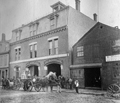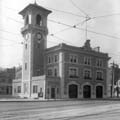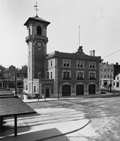|
The Society
Historical Information
Photo & Map Collections
Exploring Brookline
Links
Program Archives
|
Photo Collection
 |
Steam Engine, Bought by Town in 1839
The engine, purchased by the town in 1839 from the W. C. Hunneman Co., represented an important advance over the bucket-brigade methods that had prevailed to date. It was a suction-type engine capable of drawing water from streams and other water sources and then propelling it through a hose. The purchase also presented the opportunity to break the existing sharing of fire-fighting resources with Roxbury with the creation of the Brookline Engine Co. #1.
|
 |
Amoskeag Steam Engine
The town’s first steam-powered engine, purchased in 1873. Steam-powered pumping of water represented an important improvement over the hand-pumping that was previously required. This photo appeared as part of this article in the March 29, 1956 issue of the Brookline Citizen:
Former Resident Identifies First Brookline Fire Engine
In the 250th anniversary issue of the CITIZEN we used a picture which we had been able to identify only as the first steam fire engine owned by Brookline. Found in the files of the public library, there was no further identification to be had there.
Chief George L. Gettings of the fire department became interested and searched old scrapbooks of the fire department without being able to unearth any further material. We did find advertising pictures of both the Amoskeag and the Hunneman machines but a good deal of comparison with the photograph didn’t convince either Chief Gettings or the anniversary issue editor that we were safe in making a “statement”. There are, after all, too many fire buffs among us these days!
The following very nice letter from Mr. Alfred P. Waterman, who was born in the house still standing at 20 Aspinwall Ave. in 1873, not only answers the question we posed but provides the gratifying information that the citizen “gets around”. Mr. Waterman writes from his present home at 3142 13th St N, St Petersburg, FL:
“I have been reading with much interest the 250th anniversary number of the CITIZEN and wish to congratulate all who had a part in its publication. Having been born in Brookline and having lived there from 1873 to 1938, I found many things in it which were very familiar to me.
Regarding the item on the fire department – the Joseph Thomas Waterman mentioned was my father [ed. The 1865 creation of " Good Intent Hose Co." heralded a much more sophisticated approach to fire fighting in the town and the first Board of Fire Engineers was created to oversee those efforts. J. Thomas Waterman was a carpenter who was appointed to the board.] and I know from my family that he went to New Hampshire and gave the order for this engine to the Amoskeag Manufacturing Co. so the engine was an Amoskeag.
He was a member of the Good Intent Hose Company of that time and I believe you will find in the Brookline Town Report of that year about the purchase of this piece of apparatus. If I can be of any further assistance in giving old Brookline information, especially the section from Pond Ave. to Coolidge Corner, please let me know.”
[Source: Digital Commonwealth]
|
 |
George Stone Hook and Ladder Company, Washington St. at Cypress St., May 30, 1873
In front of Samuel Croft house. Fire house two blocks away across from the public library.
(Sitting Left to Right) Ed Witherell, E. Frank Proctor, J.C. Bense, W.H. Fuller, George H. Johnson, B. Frank Bartlett
(Standing Left to Right)Alfred Kenrick Jr., John Witherell, Samuel Richards, A. Eugene Kenrick, James Sinclair, R.L. Proctor, Herbert Mayo, Frank Spinney, Ed. F. Palmer, Charles J. Funk
|
 |
Lower Washington St., circa 1875
Looking at the south side of Lower Washington St. High St. is just to the right. From left to right:
- Stores in the “White Block”
- Good Intent Hose Company No. 1. This brick building, constructed at significant cost, was completed in January 1872 and headed the town’s progression to a well-organized fire-fighting system after years of more haphazard efforts. It housed a hose carriage and a steam fire engine.
- Thomas Parsons Steam Fire Engine (pictured in front)
- Royal Woodward, Blacksmith
[Source: Brookline Public Library]
|
 |
Good Intent Hose Company, Lower Washington St., Brookline Village
Start of Boylston St. to the right going west; lower Washington St. toward Boston to the left. This brick building, constructed at significant cost, was completed in January 1872 and headed the town’s progression to a well-organized fire-fighting system after years of more haphazard efforts. It housed a hose carriage for the Good Intent Hose Company No. 1. and the Thomas Parsons Steam Fire Engine.
From stereoscope. "Engine and Hose House, Brookline. E.R. Hills, Photographer, Brookline Mass.” Gift of Natick Historical Society.
|
 |
Hose House #1, Brookline Village, 1891
Decorated, in a deliberately macabre fashion, for the annual Horribles Parade, 7/4/1891, for which it won the best-decorated building town prize.
|
 |
Lower Washington St., Brookline Village, circa 1898
Looking east at Lower Washington St. from Boylston St. This photo contains a rare view of the north side of Lower Washington St.
On the far left is the wooden structure known as the "Russell Block". From left to right it houses:
- [153 Washington St.] The kitchenware and variety store of Albert Levien. Levien was a Russian immigrant who arrived in the United States in 1882, at the age of nineteen. He first had a store just over the Boston border on Tremont St. but soon moved to this location in 1888. He lived upstairs for the first sixteen years and maintained the store for over thirty years.
- [145-147 Washington St.] The store with the three awnings is the provisions store of Thomas S. Brown
- [137-139 Washington St.] J. V. Pyne & Co., dry goods
The large brick building to the right of the Russell Block, 127-131 Washington St., houses Jacob Morlock's "Bakery, Restaurant, Provisions" with the Morlock Hotel on the upper floors.
On the right side of the photo, from right to left, the identifiable structures are Hose House #1/Ladder #2 followed by Sing Lee’s Laundry. Hook and Ladder Co. #2 was only briefly located here, between late 1897 to mid-1899, before moving to the fire station at 342 Washington St.
[Source: Digital Commonwealth]
|
 |
Hose #1 House, Lower Washington St., Brookline Village, circa 1905
Formerly Good Intent Hose Company. Note mural in middle of façade.
|
 |
Lower Washington St., Brookline Village, circa 1905
The businesses viewed here, along the south side of Lower Washington St., were simultaneously sited at this location from 1904 - 1906. All the structures in this photo were demolished in 1907-1908 to make way for the new fire station which opened in 1909 and remains in use today. Note the man with his wheeled bucket, center photo, presumably scooping up horse droppings. Viewed from left to right:
- The business with the partial view of an awning is at the corner with Walnut St., the last building in this row. The best estimation is that it is the store of James Heleotis and John Sigalos Co., fruit [1904-1906]. The awning appears to advertise "Ice Cream Sodas" mirroring the sign at the corner entranceway visible in other photos.
- An enigmatic sign over the alleyway that seems to advertise a shooting gallery. This is currently unidentified.
- By the delivery wagon at #126 Washington St. are William Frawley, shoemaker [1889-1907]; and a bootblack, either W. L. Jacklin [1904] or Cromwell Felton [1905-1907].
- C. E. Riley, Cigars at #128 Washington St. [1900-1907]
- The awning at 134 Washington St. George W. Rix, Provisions and Transfer Market [1904-1907]
- Sing Lee, laundry, which was at #136 Washington St. for over 20 years [1883-1907]
- Hose House #1 and Chemical Engine #1 at #140 Washington St.
- P. J. Burns, Horse Shoe Forge at #144 Washington St. [1897-1907]
- Also at 144 Washington St. there remains a sign for R. Woodward who had a horse-shoeing business there from the 1860s until his death in 1892
- J. H. Pineo, carpenter and builder at 4 High St. (visible at corner of Washington St) [1901-1907]
|
 |
Fire Station #1, Brookline Village, circa 1908
Washington St. in foreground coming from Huntington Ave. Boston, looking west to Boylston St. Hose House #1 and adjacent buildings torn down. New station completed in 1908 and is still in use today.
|
 |
Fire Station #1, Brookline Village, 1909
Trolley station not yet evident.
From postcard mailed October 8, 1909 by Katie, 150 Cypress St. Brookline
|
 |
Fire Station #1, Brookline Village, 1909
|
 |
Brookline Village, circa 1910
Fire station #1 and the new trolley island
|
 |
Fire Station #1, Brookline Village, circa 1910
From left to right:
- 32 Allerton St., rear, high on the hill (still standing)
- 34 Walnut St., Edward J. Kirker, Real Estate; Brookline Press
- 38 Walnut St.: Mark Bergstein, Tailor
- 40 Walnut St.: Eagle Hand Laundry
- The fire station. Note underground toilets to the left.
- 1 High St.: Michael W. Quinlan, Carriage Mfg.
- 9 High St., brick apartment building, partial view
[Source: Brookline Preservation Department]
|
 |
Fire Station #1, Brookline Village, circa 1910
Trolley station erected. Small bushes planted on side of station.
|
 |
Fire Station #1, Brookline Village, 1910
The 1909 Knox chemical and hose wagon, the first motorized fire-fighting vehicle purchased by the town. It was known as "Combination A" and ushered in the end of the horse-drawn era. Pictured are:
- George Murray, driver
- John Allen, Assistant Chief, next to the driver
- John O’Neil, rear, first on the left
- Two unidentified men, rear left
- Lt. Frank T. Pons, Sr., at the back
- Lt. Frank Hayes, Sr., rear right
[ref. The Brookline Chronicle, August 22, 1968, pg. 1]
|
 |
Fire Station #1, Brookline Village, 1912
Bushes are larger.
|
 |
Hook & Ladder 1, Hose House 2, Circa 1895
The building, located across Washington St. from the public library, still exists, though no longer a firehouse. It was originally the George Stone Hook and Ladder Company. Shown is the first “Hook & Ladder #1” truck. The fire stations were named according to the equipment stationed there.
There would be some confusing juggling of equipment following this photo:
- 1897: New “Hook & Ladder #1” truck purchased. This original “Hook & Ladder #1” is renamed to “Hook & Ladder #2” and moved to the fire house in the Village Square.
- 1899: The new “Hook & Ladder #1” truck is moved to the new Washington Sq. firehouse
- 1899: The older “Hook & Ladder #2” is moved back to its original location at 340 Washington St. albeit with its new name.
|
 |
Hook & Ladder 1, Hose House 2, Circa 1895
The building, located today at 350 Washington St., across from the public library, is still standing and in use as the Public Safety Building. It was built in 1873 and first housed the George Stone Hook and Ladder Company. Shown is the first “Hook & Ladder #1” truck with Fred Foster and George Newcomb (driver). The fire stations were named according to the equipment stationed there.
There would be some confusing juggling of equipment following this photo:
- 1897: New “Hook & Ladder #1” truck purchased. This original “Hook & Ladder #1” is renamed to “Hook & Ladder #2” and moved to the fire house in the Village Square.
- 1899: This new “Hook & Ladder #1” truck is moved to the new Washington Sq. firehouse
- 1899: The older “Hook & Ladder #2” is moved back to its original location at 340 Washington St. albeit with its new name.
|
 |
Hook & Ladder 1 and Hose House 2
The building, located today at 350 Washington St., across from the public library, is still standing and in use as the Public Safety Building. It was built in 1873 and first housed the George Stone Hook and Ladder Company. Shown is the wagon for Hose Co. #2 housed on the right at 342 Washington St. On the left is the station for Hook & Ladder #1 at 340 Washington St. Note the two dogs on the wagon.
[Source: Joel Shield]
|
|